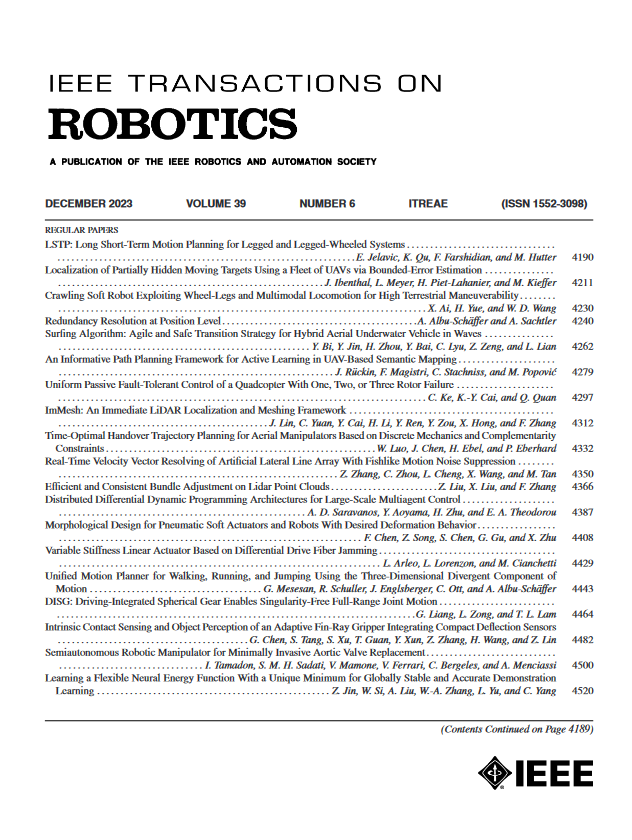High-Order Regularization Dealing With ILL-Conditioned Robot Localization Problems
IF 9.4
1区 计算机科学
Q1 ROBOTICS
引用次数: 0
Abstract
In this work, we propose a high-order regularization method to solve the ill-conditioned problems in robot localization. Numerical solutions to robot localization problems are often unstable when the problems are ill-conditioned. A typical way to solve ill-conditioned problems is regularization, and a classical regularization method is the Tikhonov regularization. It is shown that the Tikhonov regularization is a low-order case of our method. We find that the proposed method is superior to the Tikhonov regularization in approximating some ill-conditioned inverse problems, such as some basic robot localization problems. The proposed method overcomes the oversmoothing problem in the Tikhonov regularization as it uses more than one term in the approximation of the matrix inverse, and an explanation for the oversmoothing of the Tikhonov regularization is given. Moreover, one a priori criterion, which improves the numerical stability of the ill-conditioned problem, is proposed to obtain an optimal regularization matrix. As most of the regularization solutions are biased, we also provide two bias-correction techniques for the proposed high-order regularization. The simulation and experimental results using an ultra-wideband sensor network in a 3-D environment are discussed, demonstrating the performance of the proposed method.高阶正则化处理病态机器人定位问题
在这项工作中,我们提出了一种高阶正则化方法来解决机器人定位中的病态问题。机器人定位问题的数值解在病态条件下往往是不稳定的。求解病态问题的典型方法是正则化,经典的正则化方法是Tikhonov正则化。结果表明,Tikhonov正则化是该方法的一种低阶情况。我们发现该方法在逼近一些病态逆问题(如一些基本的机器人定位问题)时优于Tikhonov正则化方法。该方法克服了Tikhonov正则化中使用多项逼近矩阵逆的过平滑问题,并对Tikhonov正则化的过平滑问题给出了解释。此外,提出了一个先验准则来获得最优正则化矩阵,提高了病态问题的数值稳定性。由于大多数正则化解决方案是有偏差的,我们也提供了两种偏差校正技术,为提出的高阶正则化。讨论了三维环境下超宽带传感器网络的仿真和实验结果,验证了该方法的有效性。
本文章由计算机程序翻译,如有差异,请以英文原文为准。
求助全文
约1分钟内获得全文
求助全文
来源期刊

IEEE Transactions on Robotics
工程技术-机器人学
CiteScore
14.90
自引率
5.10%
发文量
259
审稿时长
6.0 months
期刊介绍:
The IEEE Transactions on Robotics (T-RO) is dedicated to publishing fundamental papers covering all facets of robotics, drawing on interdisciplinary approaches from computer science, control systems, electrical engineering, mathematics, mechanical engineering, and beyond. From industrial applications to service and personal assistants, surgical operations to space, underwater, and remote exploration, robots and intelligent machines play pivotal roles across various domains, including entertainment, safety, search and rescue, military applications, agriculture, and intelligent vehicles.
Special emphasis is placed on intelligent machines and systems designed for unstructured environments, where a significant portion of the environment remains unknown and beyond direct sensing or control.
 求助内容:
求助内容: 应助结果提醒方式:
应助结果提醒方式:


